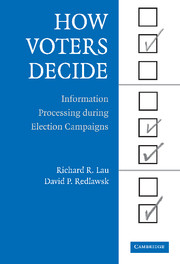Book contents
- Frontmatter
- Contents
- List of Tables and Figures
- Acknowledgments
- HOW VOTERS DECIDE
- I Theory and Methods
- II Information Processing
- III Politics
- IV Conclusion
- Appendix A Detailed Examples of Decision Strategies in Action
- Appendix B How the Dynamic Information Board Works
- Appendix C Overview of Experimental Procedures
- Appendix D Detailed Decision Scripts
- Appendix E Calculating the On-line Evaluation Counter
- References
- Index
- Titles in the series
Appendix A - Detailed Examples of Decision Strategies in Action
Published online by Cambridge University Press: 05 September 2012
- Frontmatter
- Contents
- List of Tables and Figures
- Acknowledgments
- HOW VOTERS DECIDE
- I Theory and Methods
- II Information Processing
- III Politics
- IV Conclusion
- Appendix A Detailed Examples of Decision Strategies in Action
- Appendix B How the Dynamic Information Board Works
- Appendix C Overview of Experimental Procedures
- Appendix D Detailed Decision Scripts
- Appendix E Calculating the On-line Evaluation Counter
- References
- Index
- Titles in the series
Summary
This appendix follows the efforts of a hypothetical voter Ralph as he negotiates a choice between three candidates in an election for governor of New Jersey. For convenience, we will set up a static information board that lists the three candidates across the top and eight attributes down the side. The structure of the board is shown in Figure A.1. Ralph's job is to determine which candidate he supports based on the information he has at hand about the candidates.
COMPENSATORY STRATEGIES
Model 1: Rational Choice
Weighted Additive and Expected Utility Strategies. The Weighted Additive Rule (WAdd) and the Expected Utility Rule (EU) are both formal variants of rational choice, and are thus often considered normative standards in the behavioral decision theory literature. They suggest that decision makers evaluate each alternative according to the utilities of all relevant attributes or outcomes associated with it, form an overall evaluation of each alternative, and then choose the most highly evaluated one. The two approaches differ in that the Weighted Additive Rule assumes that decision makers further consider the relative importance of each attribute to the decision at hand, whereas the Expected Utility Rule assumes that decision makers consider the probability that each outcome will occur. Hence, they both involve great cognitive complexity. Of course, there is no reason a hybrid strategy could not consider both differential importance weights and differential probabilities, although this would involve yet another magnitude of complexity.
- Type
- Chapter
- Information
- How Voters DecideInformation Processing in Election Campaigns, pp. 265 - 278Publisher: Cambridge University PressPrint publication year: 2006

